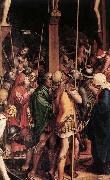Großhandels China Öl Gemälde & Rahmt Ein |
|||||||||||

|
|||||||||||
|
|
|
||||||||||||||
|
HOLBEIN, Hans the Younger
German painter (b. 1497, Augsburg, d. 1543, London). |
||||||||||||||
|
|
||||||||||||||
|
||||||||||||||
|
|
||||||||||||||
| HOLBEIN, Hans the Younger
German painter (b. 1497, Augsburg, d. 1543, London). 1524-25 Oil on limewood Kunstmuseum, ?ffentliche Kunstsammlung, Basle Here the Italianate influences are slightly stronger than in the scene of Christ before Pilate above, though no direct borrowing is observable. Holbein has adapted the smoothly elegant contrapposto stance that Andrea Mantegna had rediscovered in Roman statuary to suggest the nonchalance of the guards, just doing their job. Mantegna's frescoes in the Eremitani chapel at Padua (now damaged) are oblique sources for Holbein's, perhaps through engravings. The parallel placement of limbs, as with the green-cloaked soldier's right leg and the left arm of the guard casting lots, and the antique-style leggings and body-hugging jerkin of the guard in yellow, are southern in design. Otherwise, a sense of northern flurry and activity displaces Mantegna's calm grandeur; the touch of orientalism in the turbaned figure to the right may imply Venetian influence (through artists like Vittore Carpaccio) and contemporary chain-mail, armour and axes underpin the stark emotionalism of the figure of Saint John, with his fists clenched, behind the grieving Virgin; a combination that balances the dourly painful chiaroscuro treatment of the crucified trio overhead.Artist:HOLBEIN, Hans the Younger Title: The Passion (detail) Painted in 1501-1550 , German - - painting : religious |
||||||||||||||
|
Related Paintings to HOLBEIN, Hans the Younger :. |
||||||||||||||
|
|
||||||||||||||
|
|
||||||||||||||
|
KONTAKTIEREN Sie UNS |







